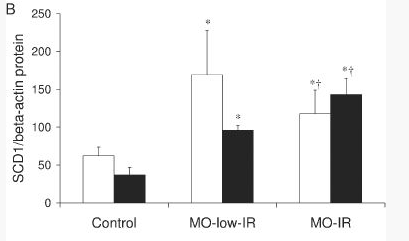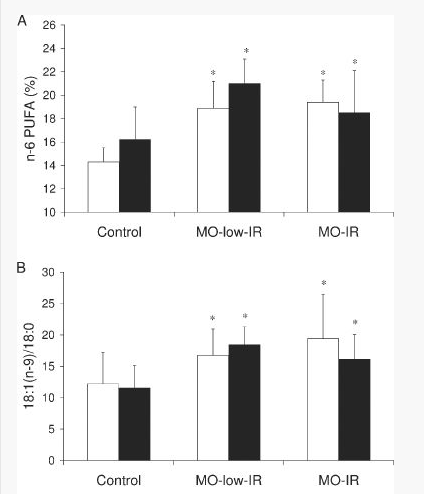This paper measured the level of Stearoyl-CoA desaturase in morbidly obese adults compared to adults with a normal BMI. The obese adults produce 2-3 times as much of the enzyme as do lean adults, resulting in fat that is significantly more unsaturated. In addition, the obese adults also had much higher levels of polyunsaturated fats. Polyunsaturated fats can only come from the diet.


The fat composition in the morbidly obese subjects would be far too unsaturated to produce a large superoxide response at the bottleneck in the mitochondrial electron transport chain due to its ability to produce sufficient FADH2 during fat oxidation. Therefore, the fat cells of the morbidly obese lack the ability to flip the switch and turn on physiological insulin resistance. ROS is the signal. Their fat cells will be knocked out of fat burning mode and into fat storing mode easily and quickly by responding to any increase in insulin levels.
If the SCD1 knockout mice are any indication, the morbidly obese subjects will presumably also have a lower metabolic rate than their lean counterparts.
How did the level of Stearoyl-CoA desaturase become elevated in the obese? That’s unclear, but the high levels of polyunsaturated fat in their fat tissue suggests that it’s NOT from their dietary fat being too saturated. There is likely a strong genetic component and sugar consumption might also be a large factor, but at the end of the day we don’t know. What we DO know is that the change in the level of this single enzyme may be a large differentiating factor in the metabolism of lean and obese subjects.
We’ve already seen that in mice, feeding a diet high in saturated fat (stearic acid) is sufficient to reduce abdominal fat stores compared to mice on a low-fat control diet and feeding a diet high in monounsaturated fat is sufficient to increase abdominal fat stores. If the obese subjects are producing so much Stearoyl-CoA desaturase, it will be hard for them to store saturated fat and therefore induce physiological insulin resistance. This may be a primary reason why weight loss is so challenging for the obese – failure to produce superoxide in the mitochondria doesn’t allow for physiological insulin resistance. ROS is the signal.
